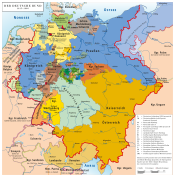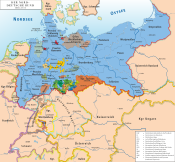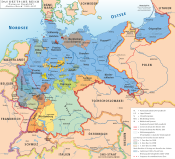| Revision as of 17:50, 1 January 2008 editCharles (talk | contribs)Extended confirmed users14,769 edits Since the Saxe-Meiningen prince as an heir actually has no source whatsoever, I'm removing it.← Previous edit | Revision as of 18:07, 1 January 2008 edit undoHenq (talk | contribs)517 edits rvNext edit → | ||
| Line 84: | Line 84: | ||
| In 1991 the Saxe-Altenburg line became extinct. | In 1991 the Saxe-Altenburg line became extinct. | ||
| Two branches descend from duke ], the father of the progenitor of this Saxe-Altenburg branch: ] and ]; according to old Wettin family law, they would have divided the actual territories between them (as happened to Gotha and Altenburg in ]). | Two branches descend from duke ], the father of the progenitor of this Saxe-Altenburg branch: ] and ]; according to old Wettin family law, they would have divided the actual territories between them (as happened to Gotha and Altenburg in ]). The senior male agnate descending from duke Ernest the Pious, in 1991 , was prince Frederick-Alfred of Saxe-Meiningen (a monk, ]-]), and thus technically succeeded then as titular duke of Saxe-Altenburg{{cn}} and head of the whole branch of Ernest the Pious (he had renounced his rights to Meiningen in favor of his uncle Bernhard, but not explicitly Altenburg). His successor was either the (morganatic) prince Frederick of Saxe-Meiningen (1935-2004) or ], the present head of that branch, depending on whether in 1997 marriage requirements were applied as strictly as fifty years earlier. | ||
| ==See also== | ==See also== | ||
Revision as of 18:07, 1 January 2008
| This article needs additional citations for verification. Please help improve this article by adding citations to reliable sources. Unsourced material may be challenged and removed. Find sources: "Saxe-Altenburg" – news · newspapers · books · scholar · JSTOR (May 2007) (Learn how and when to remove this message) |
| Duchy of Saxe-AltenburgHerzogtum Sachsen-Altenburg | |||||||||
|---|---|---|---|---|---|---|---|---|---|
| 1602 – 1672 1672 – 1825* 1826 – 1918 1918 – 1920† | |||||||||
Flag of Saxe-Altenburg
Flag
 Coat of arms
Coat of arms
| |||||||||
| Anthem: Heil unserm Herzog, heil (Hail to our Duke, hail!) | |||||||||
 Saxe-Altenburg within the German Empire Saxe-Altenburg within the German Empire  Ernestine duchies after 1825, showing Saxe-Altenburg in orange | |||||||||
| Status | State of the Holy Roman Empire, State of the German Confederation, State of the North German Confederation, State of the German Empire, State of the Weimar Republic | ||||||||
| Capital | Altenburg | ||||||||
| Government | Principality | ||||||||
| Duke | |||||||||
| • 1603–13 | Christian II, Elector of Saxony (regent for John Philip) | ||||||||
| • 1669–72 | John George II, Elector of Saxony (regent for Frederick William III) | ||||||||
| • 1826–34 | Frederick | ||||||||
| • 1908–18 | Ernst II | ||||||||
| History | |||||||||
| • Saxe-Weimar partitioned | July 7, 1602 1602 | ||||||||
| • Personal union with Saxe-Gotha | 1672–1825 | ||||||||
| • Ernestine duchies rearranged, duchy restored | November 12, 1826 | ||||||||
| • German Revolution | November 1918 1918 | ||||||||
| • Merger of Thuringia‡ | 1920 | ||||||||
| Area | |||||||||
| 1905 | 1,323 km (511 sq mi) | ||||||||
| Population | |||||||||
| • 1905 | 207,000 | ||||||||
| |||||||||
| * See Saxe-Gotha-Altenburg † As Free State of Saxe-Altenburg ‡ In 1920, the ex-Imperial states of Saxe-Altenburg, Saxe-Meiningen, Saxe-Coburg-Gotha, Saxe-Weimar-Eisenach, Schwarzburg-Sondershausen, Schwarzburg-Rudolstadt and the two principalities of Reuß all merged to form the free state of Thuringia. | |||||||||

Saxe-Altenburg (Template:Lang-de) was one of the Saxon duchies held by the Ernestine branch of the Wettin dynasty. Altenburg was its own state, with a vote in the diet, for much of the 17th century until the extinction of its ruling line in 1672, when it was inherited by the Duke of Saxe-Gotha, who married the heiress. It remained part of Saxe-Gotha-Altenburg until the extinction of that house in 1825 , when Gotha and Altenburg were split up, with Gotha going to the Duke of Saxe-Coburg-Saalfeld and Altenburg to the Duke of Saxe-Hildburghausen, who in exchange gave up Hildburghausen to the Duke of Saxe-Meiningen. This family ruled in the duchy until the end of the monarchies in 1918. Saxe-Altenburg was incorporated into the new state of Thuringia in 1920.
Saxe-Altenburg had an area of 1,323 km² and a population of 207,000 (1905). Its capital was Altenburg.
The Saxe-Altenburg line became extinct following the death of Prince George Moritz in 1991.
Dukes of Saxe-Altenburg
- Frederick, Duke of Saxe-Altenburg (1826-1834) (Previously Duke of Saxe-Hildburghausen)
- Joseph, Duke of Saxe-Altenburg (1834-1848)
- Georg, Duke of Saxe-Altenburg (1848-1853)
- Ernst I, Duke of Saxe-Altenburg (1853-1908)
- Ernst II, Duke of Saxe-Altenburg (1908-1918)
Heads of the Ducal House of Saxe-Altenburg, post monarchy
- Ernst II, Duke of Saxe-Altenburg (1918-1955)
- Georg Moritz, Hereditary Prince of Saxe-Altenburg (1955-1991)
In 1991 the Saxe-Altenburg line became extinct.
Two branches descend from duke Ernest the Pious, the father of the progenitor of this Saxe-Altenburg branch: Saxe-Meiningen and Saxe-Coburg-Gotha; according to old Wettin family law, they would have divided the actual territories between them (as happened to Gotha and Altenburg in 1826). The senior male agnate descending from duke Ernest the Pious, in 1991 , was prince Frederick-Alfred of Saxe-Meiningen (a monk, 1921-1997), and thus technically succeeded then as titular duke of Saxe-Altenburg and head of the whole branch of Ernest the Pious (he had renounced his rights to Meiningen in favor of his uncle Bernhard, but not explicitly Altenburg). His successor was either the (morganatic) prince Frederick of Saxe-Meiningen (1935-2004) or Konrad, Duke of Saxe-Meiningen, the present head of that branch, depending on whether in 1997 marriage requirements were applied as strictly as fifty years earlier.
See also
References
- "The Ernestine Line's Saxon Duchies" (Web). Historical Atlas. Tacitus Historical Atlas. Retrieved May 19, 2007.
{{cite web}}: Check date values in:|accessdate=(help)
External links
This Thuringia location article is a stub. You can help Misplaced Pages by expanding it. |
This German history article is a stub. You can help Misplaced Pages by expanding it. |
| Ernestine duchies after the Division of Erfurt (1572) | ||
|---|---|---|
|  | |
| States of the German Confederation (1815–1866) | |||||||||
|---|---|---|---|---|---|---|---|---|---|
| Empires |  | ||||||||
| Kingdoms | |||||||||
| Electorates | |||||||||
| Grand duchies | |||||||||
| Duchies |
| ||||||||
| Principalities |
| ||||||||
| Free cities | |||||||||
| |||||||||
| States of the North German Confederation (1866–1871) | ||
|---|---|---|
| Kingdoms |  | |
| Grand Duchies | ||
| Duchies | ||
| Principalities | ||
| City-states | ||
| States of the German Empire (1871–1918) | ||
|---|---|---|
| Kingdoms |
|  |
| Grand Duchies | ||
| Duchies | ||
| Principalities | ||
| City-states | ||
| Imperial Territories | ||
| Other | ||
| States of the Weimar Republic (1919–1933) | |||||||
|---|---|---|---|---|---|---|---|
| States |
|  | |||||
| City-states | |||||||
| Until 1920 |
| ||||||
| Unrecognized separatist movements | |||||||